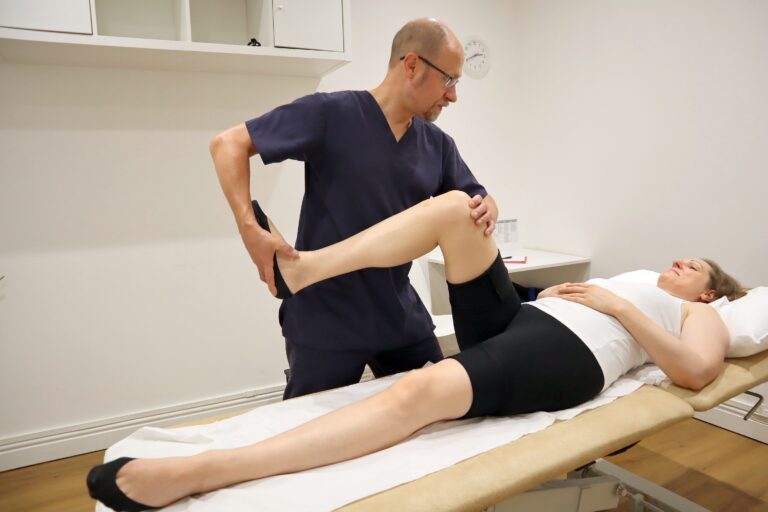
Osteopathy for Knee Pain Surrey

People who participate in rigorous sports or work out daily are no strangers to knee problems. They’re used to taking frequent trips to the pharmacy for painkillers and sprays to help relieve the pain from this common sports injury.
An Osteopath for knee pain in Surrey can help deal with such problems using multiple treatments like soft tissue massage, dry needling and mobility exercises. Our Osteopaths work with these hands-on treatments sometimes as part of a treatment plan. They do this to help the affected area’s soft tissues and reduce aches and pains.
While surgery is required for some knee injuries, osteopathy can be an effective treatment to help relieve the tension and provide pain relief for several knee issues and help with their rehabilitation. Let’s have a look at these severe knee problems.
Types of knee problems osteopathy can help with
The meniscus is a block of cartilage wedged between the thigh bone (femur) and shinbone (tibia). A meniscus tear is a common knee problem that occurs when an exceptional amount of pressure is applied to the knee joint, especially when it is bent with a rotational element.
It can also take place during exercises that require you to pivot or turn in sudden movements. People who play sports like Football, Basketball, Rugby, and Tennis are at relatively high risk for a meniscus tear.
However, you must remember that a torn meniscus is a common injury, and it’s not unique to sports. It can take place even if you stand up too fast from a squatting position.
Chondromalacia Patellae is a knee problem wherein the cartilage underneath the kneecap (patella) starts to deteriorate. This injury is a common occurrence for people who engage in heavy leg weight training (people who squat a lot of weight) and have a muscle imbalance in their thigh muscles.
Furthermore, it also appears in older adults who have knee arthritis.
The kneecap usually rests over the front of the knee joint. As the knee bends, the back of the kneecap slides over the cartilage of the thigh bone. If any of the tendons and ligaments attaching your knee to the shinbone and the thigh muscles do not function well enough, it leads to traction between the thigh bone and the kneecap.
This excessive traction can cause the cartilage to break down gradually.
In severe cases, Chondromalacia Patellae takes place due to improper knee alignment. The following possible reasons can cause this –
- Blunt force or trauma to the knee cap.
- Athletic activities like running, skiing, jumping, skipping, etc., can apply overwhelming and frequent stress to the knee joints.
- Lack of balance between the outside thigh muscles (adductors) and the inside thigh muscles (abductors).
- Weak hamstrings and quadriceps can cause stress to the knee joints.
- Weak alignment caused by a congenital condition.
Patellar Tendonopathy, also known as Jumper’s Knee, is referred to as the degradation of the patellar tendon. The patellar tendon acts as the bridge between the kneecap and the shin bone. When the knee undergoes constant and overriding stress, it can cause a tear in the patellar tendon.
Patellar Tendonopathy is common in people who regularly participate in sports involving running and jumping on hard surfaces. For example, basketball, volleyball and running, are exceedingly prone to experiencing Jumper’s knee. These activities can overwhelm the knee joint, leading to inflammation in the patellar tendon.
Patellar Tendonopathy can be recognised by the following symptoms –
- Unusual swelling in the knee.
- When you experience pain while bending and straightening the leg.
- Softening of the tissue at the lower part of the knee cap.
- Pain accompanied by jumping, running, and walking and walking downstairs.
- Pain on standing after sitting for a long time.
Please note that these symptoms are not only consistent with Patellar Tendonopathy, but they are also faced during other knee problems. Therefore, it’s important to consult your primary healthcare provider for a formal diagnosis. An Osteopath for knee pain treatment accompanied with rest can also help relieve the pain.
Knee Bursitis is a knee injury associated with the inflammation of the fluid-filled sac (bursa) located close to the knee joint. The bursae are supposed to reduce friction and protect the pressure points between the bones and the muscles, tendons, and the skin surrounding the joints.
Inflammation can become a problem for any of the bursa around the knee joint. But, Knee Bursitis usually occurs in the inner portion of the knee joint or over the knee cap. This condition leads to pain and immobility. It’s often a result of trauma to the knee caused by activities requiring one to kneel on hard surfaces regularly.
It’s important to note that this condition might not be as painful initially, but the pain increases over time.
The symptoms used to characterise Knee Bursitis commonly vary depending on which bursa is inflamed. However, some prevalent symptoms of Knee Bursitis are as followed –
- Swelling may occur with an inflamed bursa.
- In severe cases of Knee Bursitis, the joint movement becomes limited.
- Patients might experience some pain while bending the knee.
Ligaments can be defined as the tissues that grip the bones closely. Any damage to the ligaments connecting the shin bone with the thigh bone can lead to a sprained knee. There are different types of ligaments in the knee, and each sprain is characterised accordingly.
Different types of ligaments prone to tears in the knee are listed below –
- Posterior Cruciate Ligament (PCL) and anterior cruciate ligament (ACL) cross over inside the knee joint. They limit and protect the knee joint from forward and backward force.
- Lateral Collateral Ligament (LCL) is situated over the outside of the knee. It prevents the side of the knee from getting wobbly under pressure and buckling outwards.
- Medial Collateral Ligament (MCL) is present on the inside of the knee and prevents the knee from buckling inwards (knock knees).
The ligaments mentioned above are often susceptible to sprains and express themselves in several symptoms. Some of these symptoms are listed below –
- When the ACL or PCL is sprained, it’s common for patients to hear a crack as the injury takes place. Also, it feels like the knee is not strong enough to hold you up. It can be accompanied by black and blue discolouration, swelling, and grave knee pain. Furthermore, the knee feels unstable and painful to kneel.
- When the knee starts to cave into the inside of the joint, it’s a sign that the MCL has been sprained. This is often experienced with pain, swelling, and tenderness over the ligament.
An LCL sprain is characterised by the knee starting to fold towards the outside. Much like the MCL, such sprains take place alongside discomfort, inflammation, and softening of the ligament.
Osgood Schlatter’s disease is a condition that usually takes place in adolescents during growth spurts. It’s more common in adolescents who often play sports, but teens who don’t play can also experience this problem.
In this condition, the upper part of the shin is afflicted with pain and inflammation. In adolescents, the point at which bones grow is called a growth plate. The growth plate is located right above the shinbone.
Rapid movement and pressure from the quadriceps can lead to inflammation of the growth plate. Some symptoms associated with Osgood Schlatter’s are given below –
- Pain and swelling in the knee.
- Tightening of muscles in the front and the back of the thigh.
It is a condition mainly experienced by those who do a lot of running where the pain is located outside the knee. It is caused by the Ilio Tibial band rubbing the outside of the knee joint. It builds up over time and can gradually get worse, affecting everyday life. The leading causes are poor or incorrect footwear, muscle imbalance, overtraining, and excessive foot pronation.
Some symptoms of Runners knee ar
- Pain located at the outside of the affected knee
- Tightness of ITB on the outside of the thigh.
- Pain when bending and straightening the knee and going up/downstairs.
- Tenderness at the outside of the knee
At Arc osteopathy, your first appointment will be to establish the cause of your pain and stiffness through a consultation and examination. We then provide a treatment and rehab program for you.
Below you’ll find an example of a Knee Assessment. Our patients are given access to our patient video library with specific exercises videos to aid their recovery.
Ready to Be Pain-Free?
Want to recover in as little time as possible, and to be as pain-free for as long as possible?
Book your appointment now!
Ask Our Experts
Don’t live in pain; contact us today!
There’s no reason why you should keep suffering from knee pain when you can find out more by visiting your Osteopathy clinic. Our highly recommended qualified osteopaths will perform a thorough assessment and help you with your knee problems without the constant need for painkillers and anti-inflammatory medicines.
If further investigations are required, they can help direct you to the right place and offer a referral. Contact our Osteopath Croydon clinic or the Carshalton Beeches Osteopathy clinic today for more details on how our Osteopathy for knee pain treatment can help.
Patient testimonials
Alan and the team are wonderful. Have been a patient here for 2 years and followed them through both sites. The place is clean, am treated with a smile and care and always come out happy and feeling a few years younger. I would have no reservation recommending Arc Osteopathy for anyone looking for an Osteopath in Croydon.
Naz H
Alan is a very friendly, professional & knowledgeable osteopath. In my case, my neck was feeling much better after the first (same day) appointment and back to normal after a second appointment a week later. Alan also provided video exercises to improve my condition. I will highly recommend the services of Arc Osteopathy! Thank you, Alan!
Elena T
Early last year I was having terrible pain in one of my knees and could barely walk. Over a number of months Alan treated me and showed me what exercises to do and what to avoid. I am now signed off from treatment and enjoying doing everything I did before and more. Thanks to Alan.
Lorraine G
I met Alan in 2013 when I had bruises my ribs. Thanks to him, I was able to climb to the top of Mount Kinabalu in South East Asia two months later. Since then, I swear by him. I cannot recommend him enough. I drive an hour each way to see him for a 30 min session. He is the best osteopath in London.
Shamsah L







Carshalton Osteopathy Opening Times
Monday
Tuesday
Wednesday
Thursday
Friday
Saturday
Sunday
9.00 am – 2.00 pm
9.00 am – 7.30 pm
2.30 am – 8.00 pm
9.00 am – 2.00 pm
9.00 am – 6.00 pm
Closed
Closed
Monday 9.00 am – 2.00 pm
Tuesday 9.00 am – 7.30 pm
Wednesday 2.30 pm – 8.00 pm
Thursday 9.00 am – 2.00 pm
Friday 9.00 am – 6.00 pm
Saturday Closed
Sunday Closed
Croydon Osteopathy Opening Times
Monday
Tuesday
Wednesday
Thursday
Friday
Saturday
Sunday
10.00 am – 8.00 pm
11.00 am – 8.00 pm
9.00 am – 2.00 pm
9.00 am – 8.00 pm
11.00 am – 5.00 pm
9.00 am – 5.30 pm
Closed
Monday 10.00 am – 8.00 pm
Tuesday 11.00 am – 8.00 pm
Wednesday 9.00 am – 2.00 pm
Thursday 9.00 am – 8.00 pm
Friday 11.00 am – 5.00 pm
Saturday 9.00 am – 5.30 pm
Sunday Closed
